www.fxguide.com/featured/case-study-how-to-make-a-captain-america-wimp/Case study: how to make a Captain America wimp
By Mike Seymour
July 25, 2011
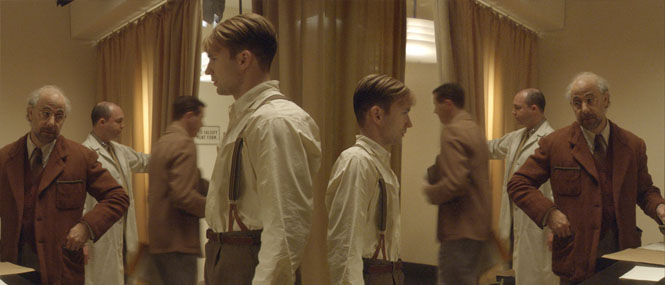

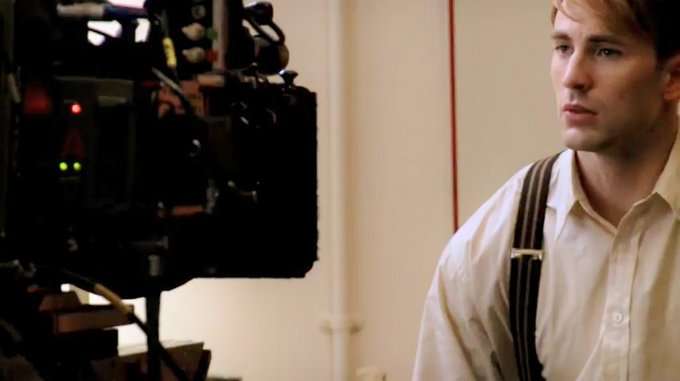
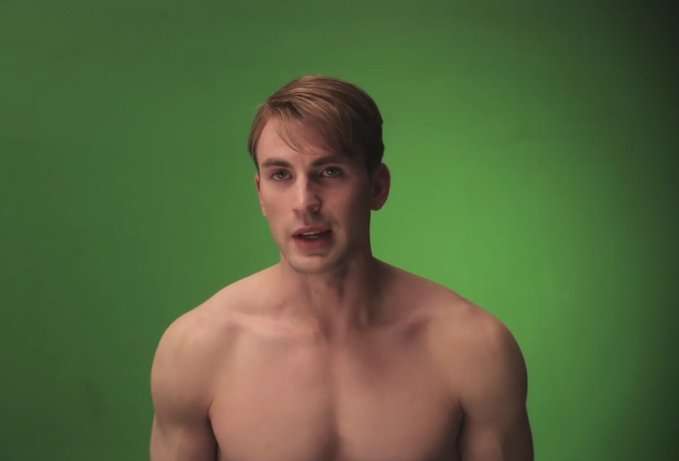
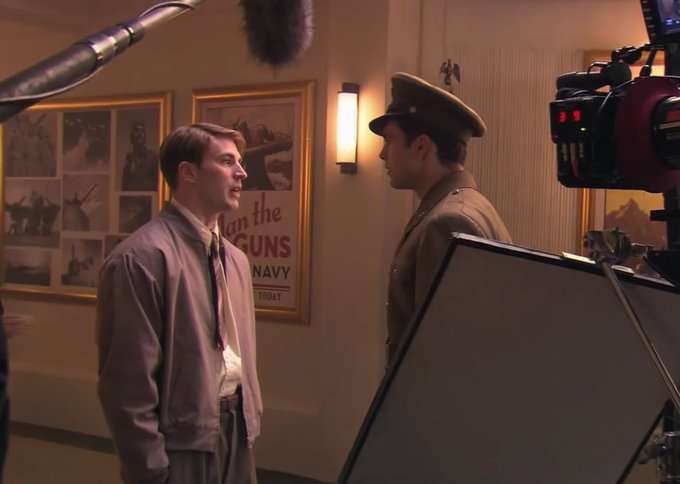
Since nearly inventing the category, the go-to facility for digital makeup in Hollywood is Lola VFX in Santa Monica. Using primarily Autodesk's Flame and a wealth of now highly specialized and experienced expert artists, Lola has carved out a lead position in anti-ageing, body trimming, face replacement and now with Captain America: wimp building.
In the Marvel film, Steve Rogers starts out as a small, short, underweight underdog, and then is transformed to the bulked up, real world shape of actor Chris Evans. This transformation was easy for Jack Kirby and Joe Simon when they first drew the character in February of 1939, but there was a real problem of how to have Evans play both the Nazi fighting All American Costumed Commando Avenger AND the pre-enhanced mild mannered wimp. While Timely Comics (later Marvel) could just publish drawings showing the same character with the same face, both buffed and wimpy, the studio's job would not be so easy.
Director Joe Johnston rejected notions of having a separate actor play the wimpy Steve Rogers, and Evans was keen to perform as directly as possible both sides of his character's persona, as we discovered when we spoke to Edson Williams, visual effects supervisor for Lola VFX.
Original plate with Chris Evans
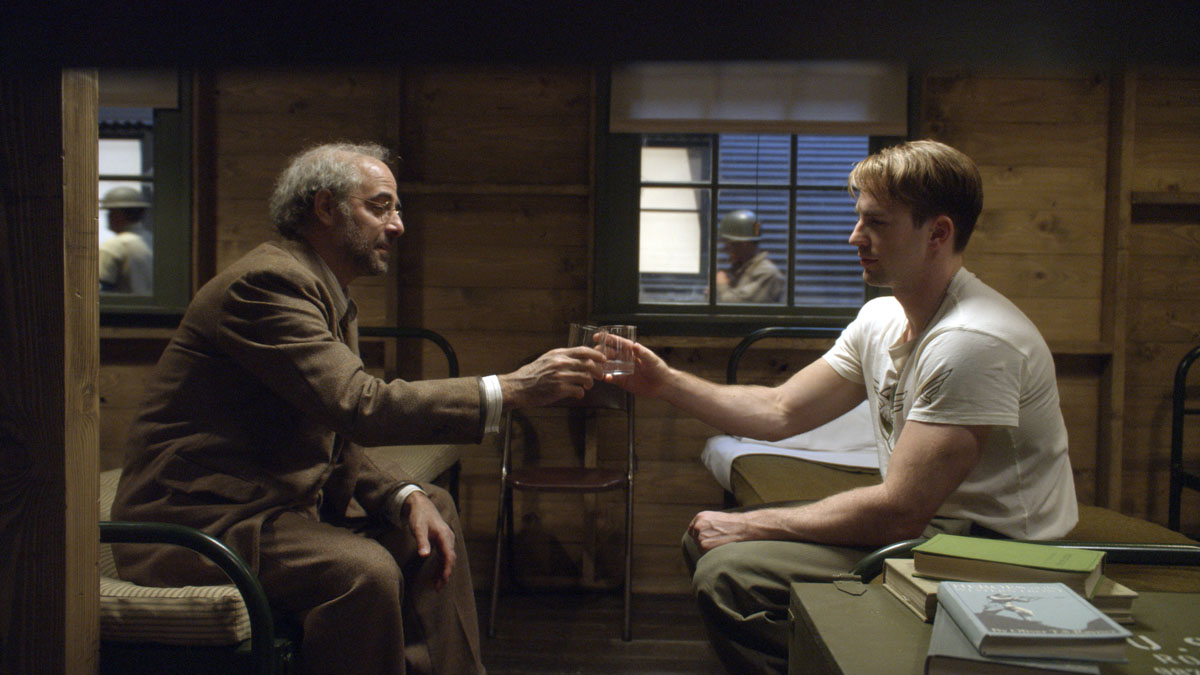
Final shot
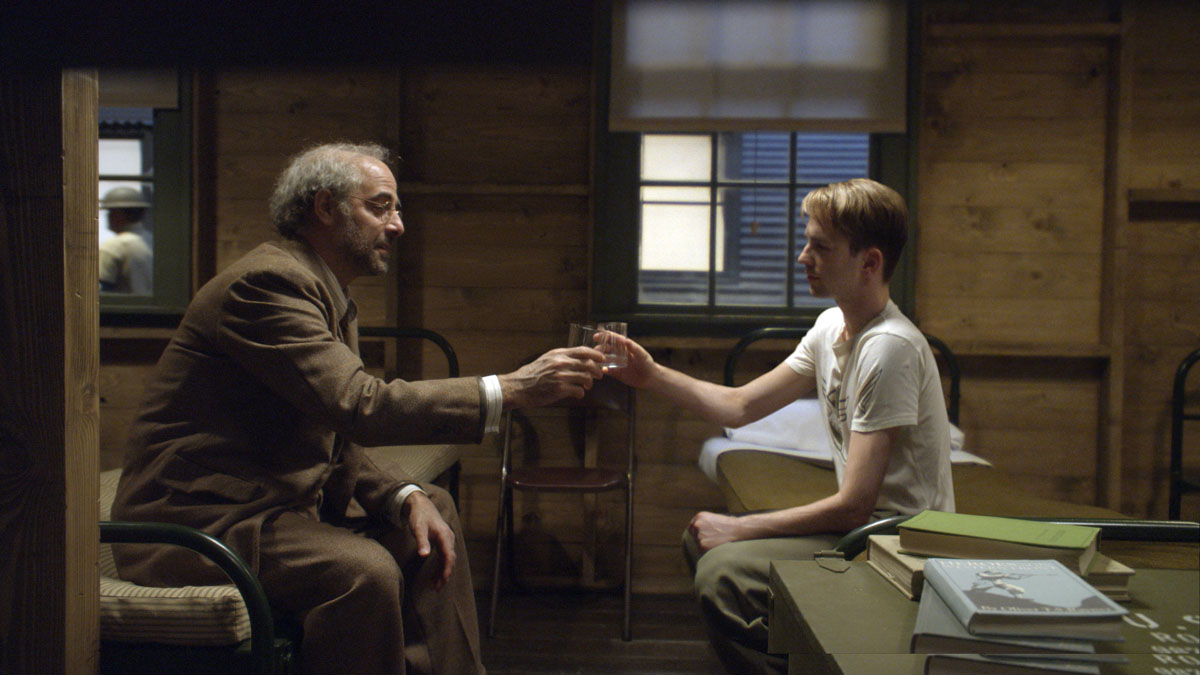
For a long time Lola's work remained a secret, both in terms of how they produced such great work but also the very existence of their work. Rumor had it that big name stars, REALLY big name stars were a little less beautiful than they appeared, and that for some never-disclosed amount, you could get a digital tummy tuck, a set of crows feet removed or a second chin lost. But it was never more than rumor, Lola never discussed its work and no actor would promote that their bum wasn't really that small.
This changed with the third X-Men film - The Last Stand - when the two lead characters were required to appear in a flash back looking years younger. Suddenly, Lola's work could be discussed. fxguide's story on this film was one of the most popular we ever published (click here), and for good reason, the work was breathtaking and rather than the result of some newly published PhD, it was all down to artist skill combined with the keen observational skills of the Lola staff. Central to Lola's success is their understanding of how a body changes over time, and over the life of a human being, from the way ears and noses continue to grow in size relative to the rest of your face - to the way the lips and the top lip in particular turns under with age, giving the impression of thinner lips. Lola has become a master of human characteristics.
Lola does employ 3D but only for reference - central to their work is just 2D compositing. This fact is either a source of amazement or humiliation - amazement at the quality of the work, and humiliation that such work has been done with basically the same tools the rest of us use daily. It is easy to dismiss great work when it is the result of specialist in-house tools, but quite another when it is apparent that it is just great artistry.
For Captain America, Lola worked on over 300 shots, which were primarily the body transformation of Chris Evans, but also some work on the nose replacement of Red Skull (80 some shots). Neither of these were classic Lola anti-aging or beauty work, but like that work required Lola's vast understanding of human form and skilled compositing. Visual effects supervisor Edson Williams describes Captain America as "definitely the biggest job we have done to date and the most challenging, but it was a lot of fun to work with, as it was something different for us." Lola did not work on Rogers after the transformation - the actor Chris Evans really is that built - "most of the shots of him as a ripped guy - that's really him," says Williams.
Lola had three primary approaches to shrinking the 220 pound (90kg) Evans to the 140 pound (63kg) guy he needed to be, while maintaining Evans' performance as closely as possible.
1. Body double / actor doubling for the entire body. The body double was English Shakespearean trained stage actor Leander Deeny (who even dieted for the role).
2. Digital head replacement / face projection - similar to the technique Lola used in The Social Network, where the actor is filmed with multiple cameras and this digital file is object tracked onto a body double's (Deeny) body. For example, when Rogers was at the recruitment center - standing semi-naked in the queue, about to be rejected near the start of the film. This was only used in about 5% of Lola's shots.
3. Shrink and scale the actor in the principal photography (no greenscreen) - a 2D scale of the actor Chris Evans. This was used in the majority - about 85% of Lola's effects shots.
Shrinking Chris EvansThe third approach of digitally shrinking the actor is highly detailed. Evans did not have much body hair, but as the skin was shrunk, the granularity of any skin texture needed to be consistent. "It was more of a grain problem than anything else," says Williams. "The scaled down sections of his body would become sharper and have very little grain. We would shrink him in some parts by as much as 30%. We took a lot of mass off. This meant we would get the skin looking sharper and as if it had no grain so we had to do a de-grain and then an over all re-grain to get the skin to match the rest of his body."
Original plate
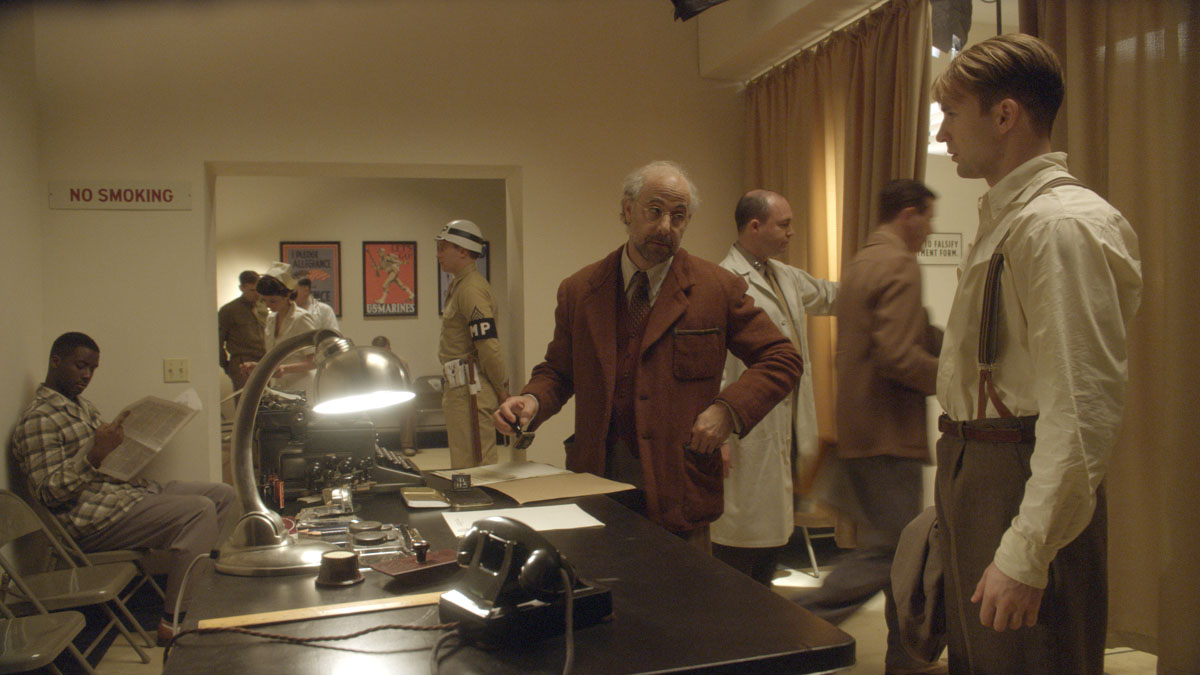
Final shot
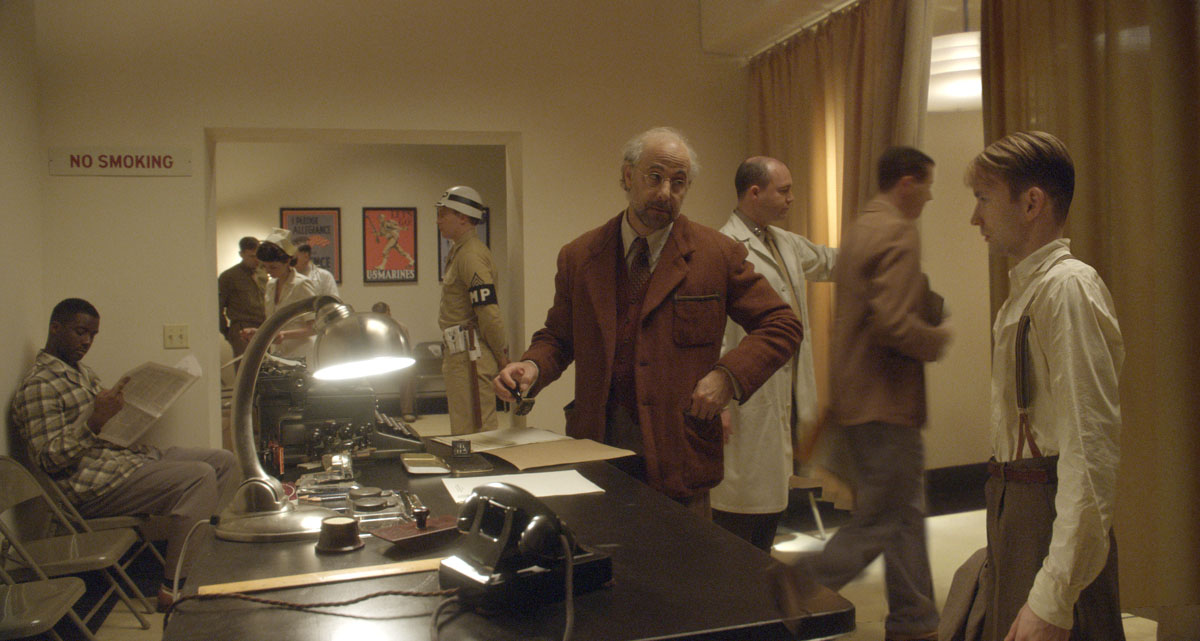
Of course, the DOP and the director lit the actor dramatically, which meant that there was a lot of shadowing to deal with. A smaller frame literally does not bulge out as much at key muscle points, so the chest pectorals for example would cast shadows down towards the abdominals. In fact, it is this very shadowing that allows one to read muscle definition normally.
As standard, one of the first things Lola does is remove and balance out shadows before adding them back in again, or, as Williams explains, "selectively removing them. It is one of the ongoing tricks we deploy. So for example, when he was sitting, his shoulder muscles would be casting a shadow down on his bicep and then at the bottom of his bicep, - near his elbow, it would also get very dark, so one of the first things we would do is go through and reduce all those shadow values, before we scaled him down. A skinny guy is not going to have shadows cast down to his belly button from his biceps, because he just doesn't have biceps."
Hands were particularly hard. While a man's body size may vary greatly with muscle mass, both hands and feet are not muscle bound, and so while an arm bicep would be reduced by say 60%, a hand may only be reduced 10% and most of the work would need to go into making the fingers more slender, and not just smaller.
Changing face
Chris Evans' head needed to be adjusted proportionally as part of the shrink. While the face, like the hands, is not a direct re-scale, the face was never the less made to be thinner, more gaunt and the cheeks fallen.
Steve Rogers does not undergo an alter ego transformation akin to the Hulk. Central to the movie is that Steve Rogers was always brave. Hence Lola's job was made more difficult as they needed the small Rogers to still be a hero, and to still be masculine. In scaling down Chris Evans, Lola had to avoid him looking girlish or feminine. The audience needed to still think of Rogers pre-transformation as a man, not a child, not as feminine. Yet most of the masculine properties of his body were being systematically removed.
One aspect that could be used to help define his masculinity without fighting the size reduction mandate was facial hair - or a 5 o'clock shadow. "Initially we took off all the 5 o'clock shadow, because even when Chris Evans has just shaved, Chris still has some 5 o'clock shadow," notes Williams "In the end we brought it back to about 40% of the original 5 o'clock shadow. Without it he looked like a boy, like a 14 year old boy."
Originally the chin was digitally rounded but for the same reason of not wanting Rogers to look like a boy, the chin was re-flattened out to make him look older. But the eyes needed to be scaled less than the chin for example to make the audience feel sorry for Rogers. "So the whole head would be scaled," says Williams. "While the jaw was scaled down 23% the eyes were only scaled down 16%." The eyes actually don't grow in your head the way the rest of your face does - which is why children seem to have big eyes - when in reality it is that the rest of their faces are just smaller proportionally. "We also started scaling down the nose but then it did not look like Chris Evans," says Williams, "'cause, you know, Chris has a manly nose and so when we made the nose smaller it did not look like Chris."
As the process progressed the team would revise 'approved shots" as they learned more and more how to successfully slim Evans, as Williams explains: "I always thought we were moving forward, but shots we thought were great - we'd learn how to make them better." Williams also says that while adjusting the face the team had to be extremely careful, for example, "the corner of the eyes, if they tilt up a little you look feminine, if you tilt them down too much you look like Sylvester Stallone."
Plate 1 - Chris Evans
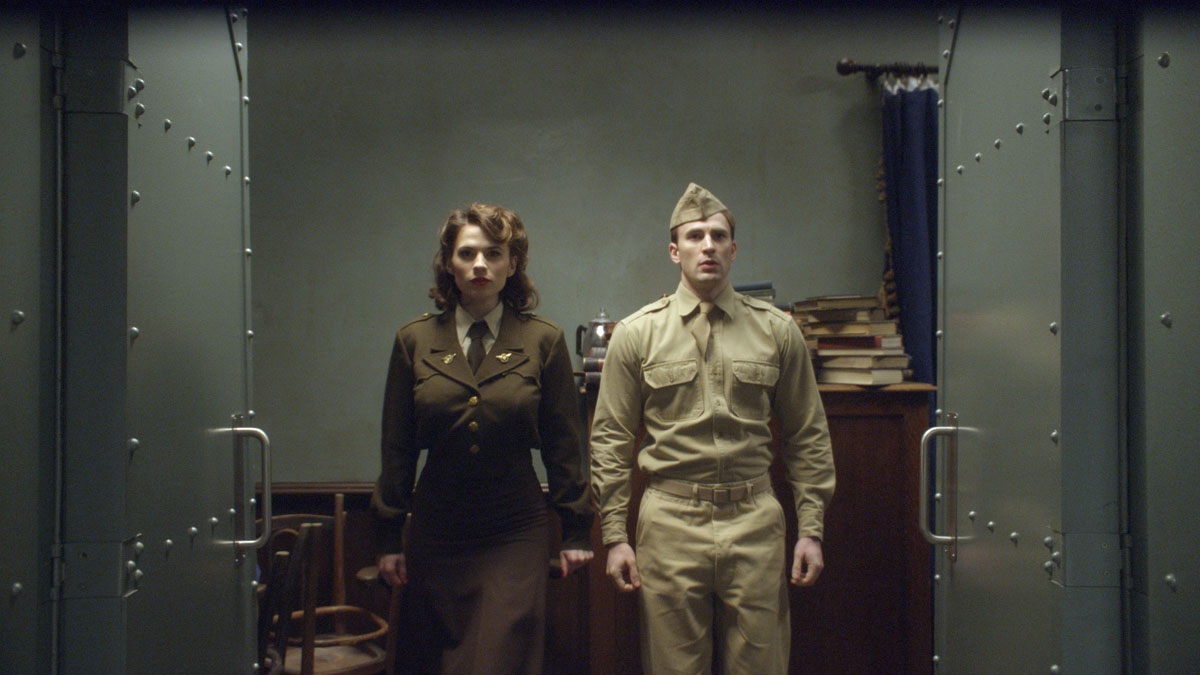
Plate 2 - Body double reference
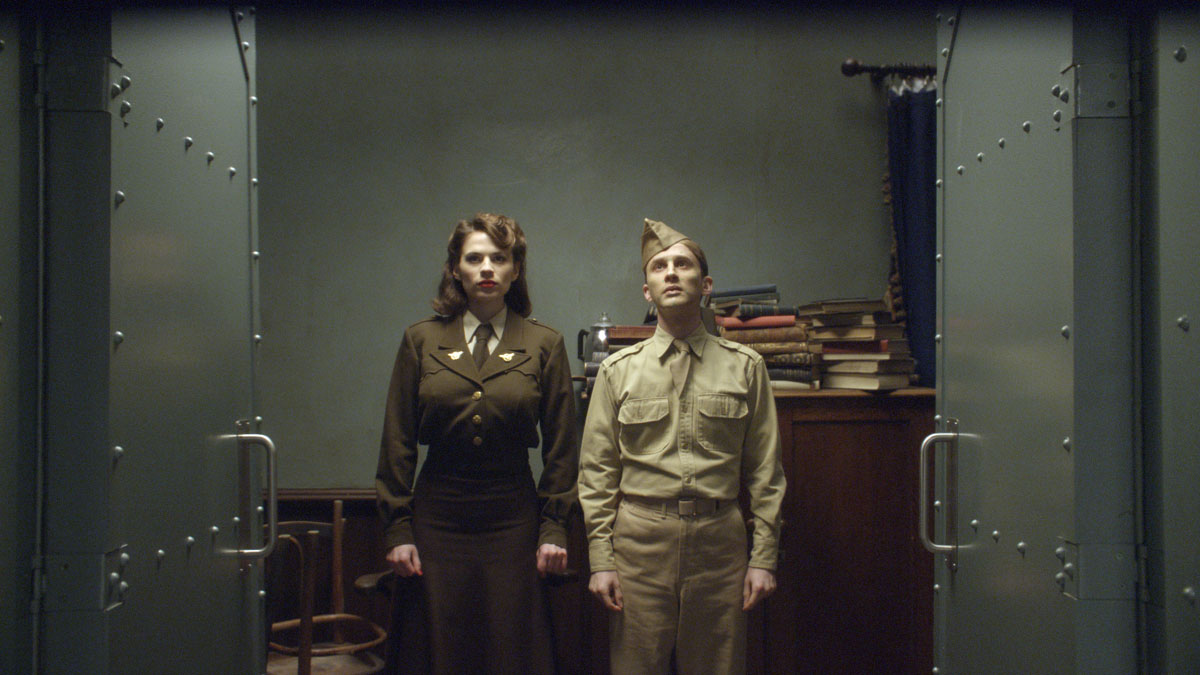
Final shot
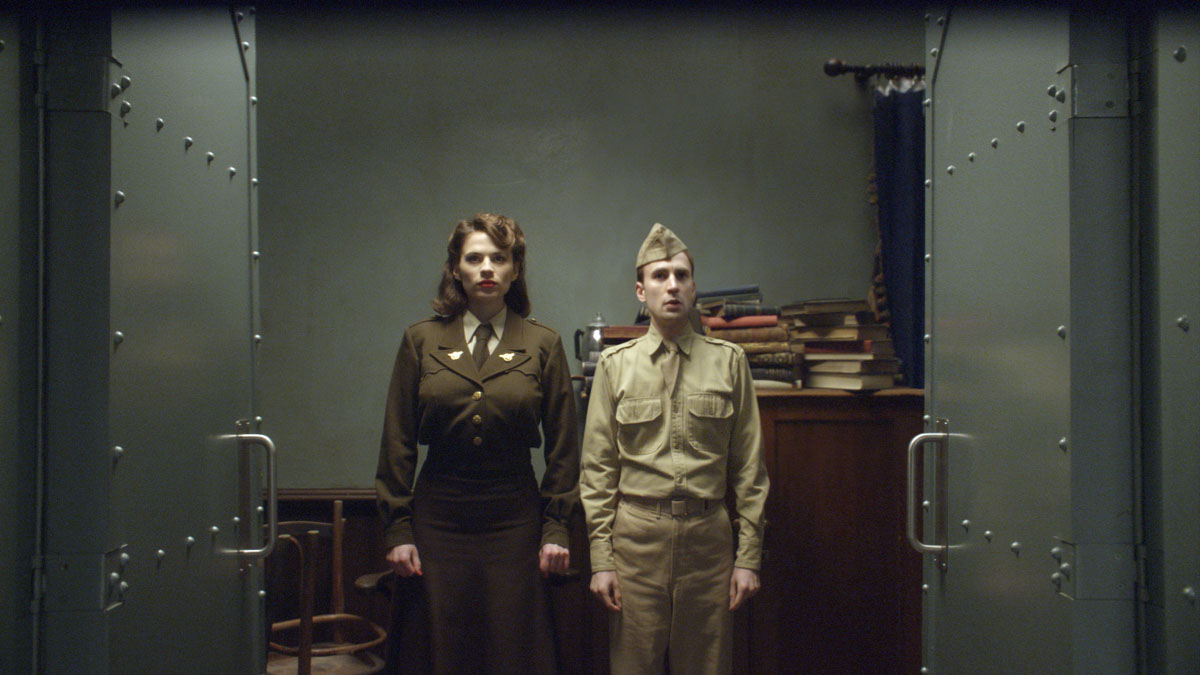
 Shooting Chris Evans
Shooting Chris EvansIn addition to the central task of shrinking Chris Evans, all the surrounding action needed to be correct, including eye lines and props. Here a number of tricks that were done on set:
- Evans would walk with bent knees, Groucho Marx style, to be lower in shot (although if he was taking more than a couple of steps this was not done as his walk and posture would be wrong.
- Evans would take shorter steps. The character Steve Rogers needed to vary between 6 ft 4" (1.93m) and 5ft 4" (1.62m), so smaller Rogers would have a smaller pace naturally. If you tried to scale the walk in post, the feet would appear to slide relative to the ground. "He would seem to moonwalk," joked Williams. Note: even body double Leander Deeny was 5ft 7" (1.70m), a full 4 inches (10cm) taller than 'Skinny Steve'.
- Seats, such as Evans' side of the taxi, would be lowered by several inches so his co-stars would naturally look down at him.
- Shirts and hats were oversized. For example, Evans wore the largest army helmet that could be found so that when he and the helmet were shrunk digitally - the helmet would look the same size as everyone else's but he would appear to barely fit it. Shirt collars were also oversized, so that when Evans was shrunk, the shirt would appear normal but too big for him, again making him look frail.
- Evans' co-stars would focus on his chin for shots where they was looking directly at him, so that when he was shrunk, their eyeline would line up with his lower positioned eyes. Evans in turn looked at the brow of his co-stars.
- If possible, production would remove things in front of Evans' face. So when Rogers is crawling through barb wire during basic training, the filmmakers would shoot the real Chris Evans pass without foreground barb wire, and then add it back later based on the reference pass filmed with it in on another pass. This clean pass would allow the slimming down process to happen without the wire being in the way and the new correct-looking, correct scale barb wire added back on top would just sell the illusion.
How to get a consistent Skinny SteveOne problem with this sort of detailed compositing work is consistency. Even in real life, the non-vfx shots of Chris Evans will have him looking slightly different shot to shot. So how do you make the artist's interpretation of Skinny Steve consistent? Lola VFX had a solution.
When the Log Genesis footage was turned over to Lola, it was normally object tracked in PFTrack, a program Williams really likes (Lola used the previous version to the new PFtrack). This fed to a scaled down 3D model of Chris Evans. The digital Evans was based on a cyberscan of the actor and then remodeled to the slimmed Evans target. Once the tracking was complete, the digital Chris Evans would be lit and rough comped into the scene. But this was only ever done as reference. By slap-comping a digital body in the shot the artists could consistently see how big the new Chris Evans should be - how big relatively each muscle would be and thus they would not be guessing or operating blindly.
For this consistency tool to work, Williams and the team had to constantly be updating their Maya Chris Evans model with the latest view of what a 'good' slimmed Evans should look like. "It was totally an iterative process," says Williams. "We kept evolving our model to keep track with what production liked." One of the hardest things about Lola's work is head turns and so while the pivot point was about an inch and a half in from the back of the neck, to align with the spline the digital reference was invaluable for what one would see frame by frame in a complex head turn.
All Lola's compositing is done on Autodesk Flame. "We have 24-25 flames and our sister company Hydraulx has another 25 flames," says Williams. "So when we want to ramp up, we can borrow even more of theirs. I don't think we could have done this shot list with anything but a Flame. Nuke's a great product, but it just doesn't have the bandwidth, horsepower and the tools set that Flame has."
Scene reconstructionNot only did the body of Chris Evans need to be reduced but the background revealed as this was done needed to be replaced. For each setup there would be three passes shot:
1. Chris Evans acting the scene
2. A body double acting the scene - often just for lighting
3. A clean pass (but not motion control)
The shots were filmed on the Panavision Genesis which only outputs 1920x1080 - but as the film was 2.35:1 not even all the vertical height was used. Williams is not a huge fan of the Genesis, preferring moving forward to explore using cameras such as the RED with its 5K resolution, since the Genesis files are not very high resolution. "The Genesis is not a good effects camera," Williams comments in declarative style.
Actually the production initially masked the video split with hard camera tape, so the director and crew would only see the active area of the frame that would be used in the final movie, the center cut or crop from the Genesis' fully recorded 1080 height. This would normally work in Lola's favor since Chris Evans would need to be scaled down. Having some image recorded, but off the top of the 'viewing screen', would normally provide Lola with some additional footage that could then be scaled down into the final frame. Unfortunately on the first few days of filming the footage was masked on the video splits in the 'video village'. No one saw that this valuable - but normally discarded - image real estate was being blocked with camera flags and matte boxes. As soon as Williams saw that their invaluable spare head material was being contaminated and lost, he let the DP know and for the rest of production this normally unused screen space was protected.
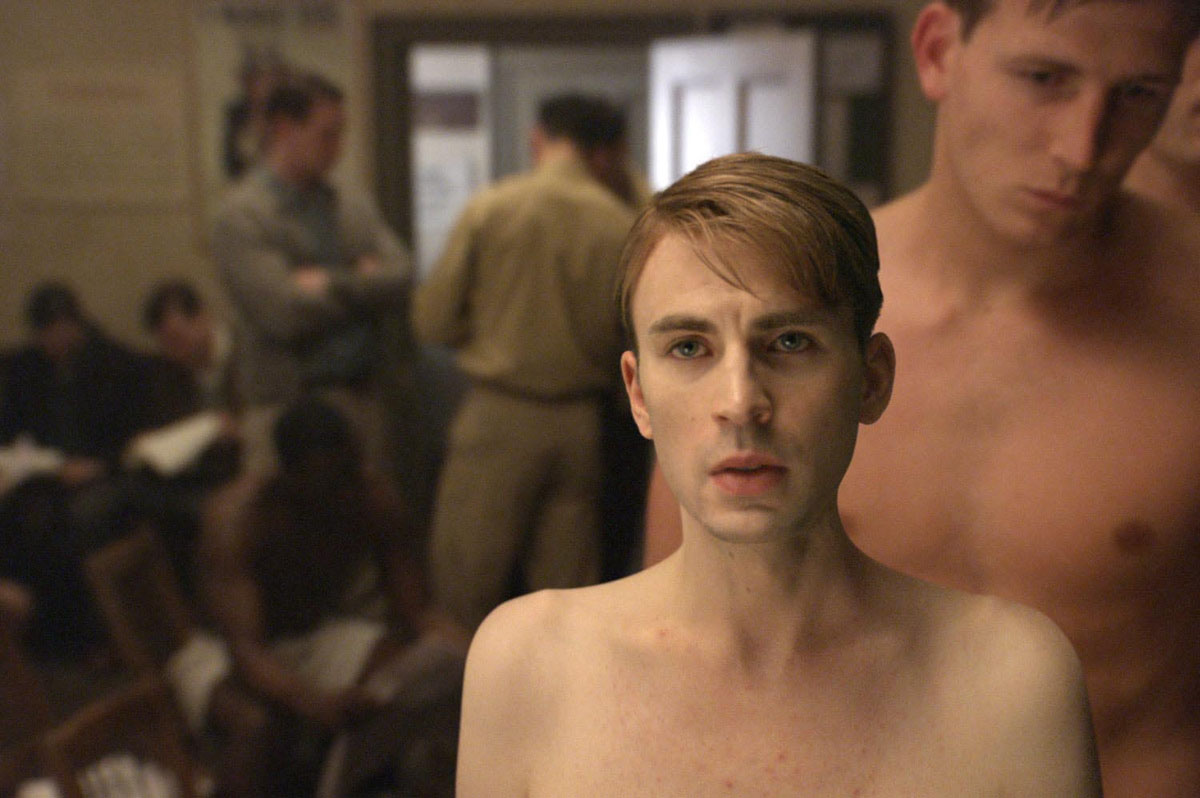
A final shot of 'Skinny Steve'
As mentioned above, in scenes where Evans was taking a few steps, the team would have the actor walk bent kneed, so that his hair was in the correct place in height, but then the team would need to bring his waist up and digitally straighten his legs as part of the process.
While there was always a clean pass, this was not motion control, so in a moving camera shot - such as Rogers in the army barracks - all that Lola got was what was jokingly referred to as 'poor man's motion control'. But in the environment of the barracks, the two plates only roughly lined up. With all the parallax and objects in the scene, background patching and replacement in this scene was some of the hardest that Lola had to do. "The plates were so dissimilar we ended up having to make a 3D background environment for that one," says Williams. "Overall we must have spent as much time cleaning up the back plates as we did slimming down Chris. Some of the clean plates were crazy. There were crowd scenes, for example at the World Expo registration center, we ended up with about four or five digital doubles." In this scene Chris Evans needed to walk down some stairs and have people pass him. Walking 'groucho-style' is not possible when walking down stairs, so "as people walking behind him started to get close to him they would merge into digi-doubles," says Williams. "They would then pass him and then fade back into the original performances again as they cleared him."
Another scene that had very complex background cleanup was the alley fight scene. Nearly all the shots in this fight were a scaled Chris Evans, with the exception of the actual face punch, which was a face projection shot, but the background replacement was so vast as the real Evans covered so much of the frame. Williams and his team digitally recreated the alley from the clean plate and then digitally projected it onto matching background geometry and composited it into the hero take, fixing about 25% of the alley.
In all shots Leander Deeny was a lighting and body reference, although as he was a stage actor and not a screen actor first and foremost, his style was a little different than Chris Evans. "He was very dramatic," notes Williams. "If the sun was coming up, he was like 'Look the Sun is coming UP' - so his moves were stagey - very dramatic." A lot of his moves Lola couldn't use as a reference - as a lot of Deeny's moves were very dramatic - more of a stage presence and Chris, by contrast, was more fluid. Says Williams: "Chris was more of a cinematic actor instead of a stage actor, but having Leander's body was always helpful as we could always see his proportions."
A final note"The production was actually really good to work with," says Williams. "They would say wherever possible use Chris Evans but if you can't - do whatever you can to make it work and they were just really supportive." Chris Townsend, in particular "was terrific," says Williams, who clearly enjoyed working with the production VFX supervisor. Williams says that during their cineSync review sessions, Townsend was particularly useful as "his drawings were just amazing. He would be quick, fluid and he would nail it almost every time. He knows what fights to fight. He knows that if a shot is 98% he might say, 'OK, let's leave that and put our efforts into these other shots'. As he comes from a compositing background, he knows how much work it would take to move it any further. His notes are concise, timely and he has a great eye."
"It was one of the best working experiences I've had," Williams adds enthusiastically.
All images courtesy of Paramount Pictures and Marvel Studios.
A compilation of Pre-Serum Steve in The First Avenger
Bob's tribute video
